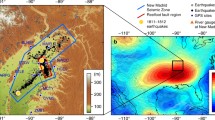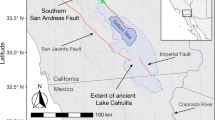Abstract
— During the late nineteenth century, coastal parts of northern California experienced seismicity which was more intense than at any other time in its historical record and was concentrated in Spring. The seasonal character of this anomalous seismicity was statistically significant from the 1880s, if not earlier, until the time of the great 1906 earthquake. It can be explained as a result of seasonal stress transients caused by the large seasonal sediment loads which accumulated in coastal bays that overlie active strike-slip faults, as a result of hydraulic mining of gold in inland areas. Such localised loading will increase the absolute vertical stress and reduce the absolute horizontal stress, thus facilitating shear failure by unclamping vertical fault planes. However, rather than simply influencing the timing of earthquakes which would otherwise have occurred anyway sometime later, this process appears to have affected the character of the region's seismicity, causing a sequence of magnitude 5–6 earthquakes which propagated outward from these coastal depocentres. These results have three important implications. First, the proposed physical mechanism is only feasible provided the deepest continental crust in this region has a viscosity no greater than ∼1017 Pa s, giving it a Maxwell time of the order of weeks. These observations of seasonal seismicity thus suggest that such low viscosities are reasonable, a conclusion which has been difficult to establish using other evidence. They indicate that future calculations of the stress field in this region, for instance for investigating the role of earthquake triggering, should incorporate this response by lower-crustal flow, not just the immediate elastic effect. Second, the conclusion that seasonal stress transients caused by seasonal changes in surface processes can affect seismicity, has important implications for hazard assessment. It raises the possibility that surface processes may influence the seasonal timing and character of seismicity in other regions also. Finally, it indicates that the decades of intense seismicity, widely interpreted as precursory activity to the 1906 earthquake, were atypical of the longer-term record. Analogous sequences of moderate-sized events cannot necessarily be expected to provide advance warning of future large earthquakes in this region.
Similar content being viewed by others
Author information
Authors and Affiliations
Additional information
(Received April 20, 2000, revised/accepted September 18, 2000)
Rights and permissions
About this article
Cite this article
Westaway, R. Seasonal Seismicity of Northern California Before the Great 1906 Earthquake. Pure appl. geophys. 159, 7–62 (2002). https://doi.org/10.1007/PL00001268
Issue Date:
DOI: https://doi.org/10.1007/PL00001268




